First off, you need the fedora. The gangster accessory de rigueur, 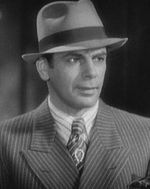 it was already iconic by the time Paul Muni popularized the look in Scarface (1932). Al Capone, Clyde Barrow, John Dillinger, Machine Gun Kelly were all photographed wearing one. Baby Face Nelson was astute enough to recognize the souvenir value of his trademark fedora, bartering it for food and a place to hide after a botched bank job.
it was already iconic by the time Paul Muni popularized the look in Scarface (1932). Al Capone, Clyde Barrow, John Dillinger, Machine Gun Kelly were all photographed wearing one. Baby Face Nelson was astute enough to recognize the souvenir value of his trademark fedora, bartering it for food and a place to hide after a botched bank job.
By the time Bogey donned one to play‘Bugs’ Fenner alongside Edward G. Robinson in Bullets or Ballots (1936), it was a bit passé. Robinson, you will note, sports a derby, signaling his authority over his fedora-wearing lackeys. (That’s Bogey on the right, with the gun.) 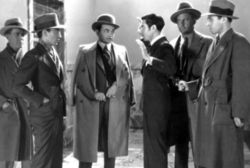
Leave it to the French to reinvent the gangster look and give it panache. In Pépé le Moko (1937), Jean Gabin wears the hat, but he adds a gallic touch: a silk scarf. 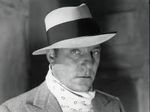 Gabin’s character has style—something his American counterparts lacked—but more importantly, he’s got heart. Love will be his undoing, and we’re not talking about a fling with some cheap, two-timing dame. We’re talking epic love, the kind of love that inspires poetry and songs. Ah, l’amour.
Gabin’s character has style—something his American counterparts lacked—but more importantly, he’s got heart. Love will be his undoing, and we’re not talking about a fling with some cheap, two-timing dame. We’re talking epic love, the kind of love that inspires poetry and songs. Ah, l’amour.
Director Julien Duvivier gives us a tragic hero in the classical tradition who is the victim of fate. Pépé is wanted in France for various crimes. He’s been hiding out in the Casbah of Algiers for two years, sheltered by the local inhabitants who will take any opportunity to defy the colonial authorities. He may be king of the Algerian underworld, but exile has turned bitter for Pépé, whose longing for Paris recalls Ovid’s lament in the Tristia: “Say that I died when I lost my native land.”
After Pépé, Gabin would go on to play his greatest role, the working-class Lieutenant Maréchal, in Renoir’s Grand Illusion (1937). 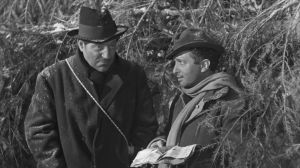 He got to wear a fedora in that picture too, alongside Marcel Dalio. In much the same way that John Wayne seemed to embody the fiercely independent American spirit, Gabin “epitomized the values French people like to think of as their own: cool intelligence, open-hearted love of life, courage, moral rectitude,” as one critic put it after the actor’s death.
He got to wear a fedora in that picture too, alongside Marcel Dalio. In much the same way that John Wayne seemed to embody the fiercely independent American spirit, Gabin “epitomized the values French people like to think of as their own: cool intelligence, open-hearted love of life, courage, moral rectitude,” as one critic put it after the actor’s death.
The martyred Resistance leader Jean Moulin (below, right) favored the scarf-and-fedora style of the French gangster. Perhaps he was fashioning himself as a romantic outlaw. 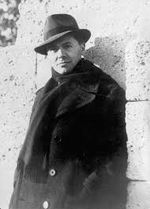 Over time, Moulin’s image became even more Pépé-like. Here (below, left) is how Claude Berri imagined him in Lucie Aubrac, his 1997 picture about the Lyon Resistance heroine.
Over time, Moulin’s image became even more Pépé-like. Here (below, left) is how Claude Berri imagined him in Lucie Aubrac, his 1997 picture about the Lyon Resistance heroine.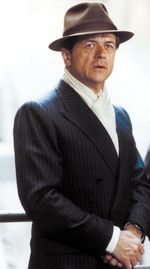
Alas, something happened to the French gangster after World War II. You notice it right away in Bob le flambeur (1956). The gambler played by Roger Duchesne is a natty dresser. He’s got the fedora and a trench coat, opting for the full American look (i.e., no scarf) in keeping with his American nickname. He’s got a classy apartment too, complete with his own personal slot machine in the closet, drives a big American convertible, and lives by a code of honor that sets him apart from the riffraff he consorts with in Montmartre. So why the jaded expression?
Bob’s on a losing streak. It’s more than bad luck;  the malaise seems existential, maybe not full-blown angst, but Bob is listless, out of sorts. We watch him wandering the city streets, proceeding aimlessly from one back-room card game to another, catching a few hours of sleep before heading off to the races where he actually wins, only to gamble it away in a matter of hours. He doesn’t care, either way, and nor do we.
the malaise seems existential, maybe not full-blown angst, but Bob is listless, out of sorts. We watch him wandering the city streets, proceeding aimlessly from one back-room card game to another, catching a few hours of sleep before heading off to the races where he actually wins, only to gamble it away in a matter of hours. He doesn’t care, either way, and nor do we.
Don’t get me wrong. Bob le flambeur is a delightful movie. You’ve got Paris, enchantingly shot with a hand-held camera in the rough-edged, documentary manner that would become the hallmark of New Wave cinema. You’ve got your low-life criminals, a heist, and a couple of double-crossing dames. Then there’s the pleasure in hearing the French pronounce the name Bob, which comes out sounding more like “Bub” than “Bahb,” which is how we Americans say it. Try it: purse your lips first, so the word forms in the front of your mouth, then say “Bob” very fast, allowing the syllable to resonate inside your nose.
Jean-Pierre Melville, who directed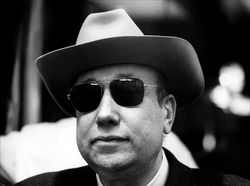 Bob le flambeur, loved all things American. “Melville” was his nom de guerre in the French Resistance, which he continued to use professionally for the rest of his life. He drove a convertible like Bob’s, although sartorially speaking, he went for the Western look—cowboy boots and a Stetson—and liked cruising around Paris late at night with the top down.
Bob le flambeur, loved all things American. “Melville” was his nom de guerre in the French Resistance, which he continued to use professionally for the rest of his life. He drove a convertible like Bob’s, although sartorially speaking, he went for the Western look—cowboy boots and a Stetson—and liked cruising around Paris late at night with the top down.
The tough-guy persona was more than a pose. Melville was a man of few words. He didn’t speak of his time in the Resistance, for example, but his film of Joseph Kessel’s wartime novel, Army of Shadows (1943), punctured the myths that the French still cherished in 1969, when the film was released. Not many people resisted the nazis, and those who joined the underground did so out of a variety of motives, not all of them admirable. Yes, there was courage, and sacrifice for the sake of others, but the small, quiet acts of decency were no less stunning than the grandiose gestures. Melville’s heroes were complicated people, as befits a time when choices were not black and white, but gray.
Which brings us back to Bob. There’s no place for him in postwar France, and he knows it. The style, the conventions, are all that’s left of a vanished world, and yet Bob takes perverse satisfaction in playing by the old rules, keeping up appearances. Coolness has its consolations. He can’t pull off the heist, but he can pull off the look.
By the time we get to Breathless (1959), even the look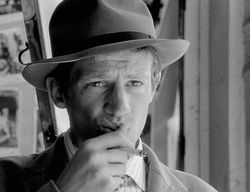 is degraded. Here’s Belmondo practicing his cool in the mirror, posing with a gun, trying to convince everybody he’s a gangster, starting with himself. We see him imitating Bogey. He’s got the gesture down, has trained himself to talk with a cigarette dangling from his lips. And check out that fedora!
is degraded. Here’s Belmondo practicing his cool in the mirror, posing with a gun, trying to convince everybody he’s a gangster, starting with himself. We see him imitating Bogey. He’s got the gesture down, has trained himself to talk with a cigarette dangling from his lips. And check out that fedora!
Jean-Luc Godard layers on the clichés. Soon the cops are on Belmondo’s tail. He’s a wanted man, forced to go underground. He even gets himself tangled up with a double-crossing dame, an American, no less.
Pépé gave the American gangster a dash of French flair. Bob (Bub) wore his American name, along with his fedora, like a true Frenchman. Belmondo’s character is just a punk, but he’s a French punk and, wouldn’t you know it, the guy’s style has endured.



 He got to wear a fedora in that picture too, alongside Marcel Dalio. In much the same way that John Wayne seemed to embody the fiercely independent American spirit, Gabin “epitomized the values French people like to think of as their own: cool intelligence, open-hearted love of life, courage, moral rectitude,” as one critic put it after the actor’s death.
He got to wear a fedora in that picture too, alongside Marcel Dalio. In much the same way that John Wayne seemed to embody the fiercely independent American spirit, Gabin “epitomized the values French people like to think of as their own: cool intelligence, open-hearted love of life, courage, moral rectitude,” as one critic put it after the actor’s death. the malaise seems existential, maybe not full-blown angst, but Bob is listless, out of sorts. We watch him wandering the city streets, proceeding aimlessly from one back-room card game to another, catching a few hours of sleep before heading off to the races where he actually wins, only to gamble it away in a matter of hours. He doesn’t care, either way, and nor do we.
the malaise seems existential, maybe not full-blown angst, but Bob is listless, out of sorts. We watch him wandering the city streets, proceeding aimlessly from one back-room card game to another, catching a few hours of sleep before heading off to the races where he actually wins, only to gamble it away in a matter of hours. He doesn’t care, either way, and nor do we. John Huston directing his own screenplay of the great Dashiell Hammett novel. No wonder Roger Ebert called “The Maltese Falcon” one of the greatest films of all time.
John Huston directing his own screenplay of the great Dashiell Hammett novel. No wonder Roger Ebert called “The Maltese Falcon” one of the greatest films of all time. and tell her in no uncertain terms: Honey, forget him. He’s bad news, even if he’s not a murderer. Sure, he’s Humphrey Bogart, and a very vulnerable Humphrey Bogart at that, but he’s trouble from the get-go.
and tell her in no uncertain terms: Honey, forget him. He’s bad news, even if he’s not a murderer. Sure, he’s Humphrey Bogart, and a very vulnerable Humphrey Bogart at that, but he’s trouble from the get-go. Flash forward three weeks and he’s grown cuddly. Nothing like the love of a good woman to turn a guy around. But soon it’s Grahame’s character who’s a basket case. She suspects Bogey of murder (with good reason) and he picks up on her doubts and gets paranoid and possessive.
Flash forward three weeks and he’s grown cuddly. Nothing like the love of a good woman to turn a guy around. But soon it’s Grahame’s character who’s a basket case. She suspects Bogey of murder (with good reason) and he picks up on her doubts and gets paranoid and possessive.